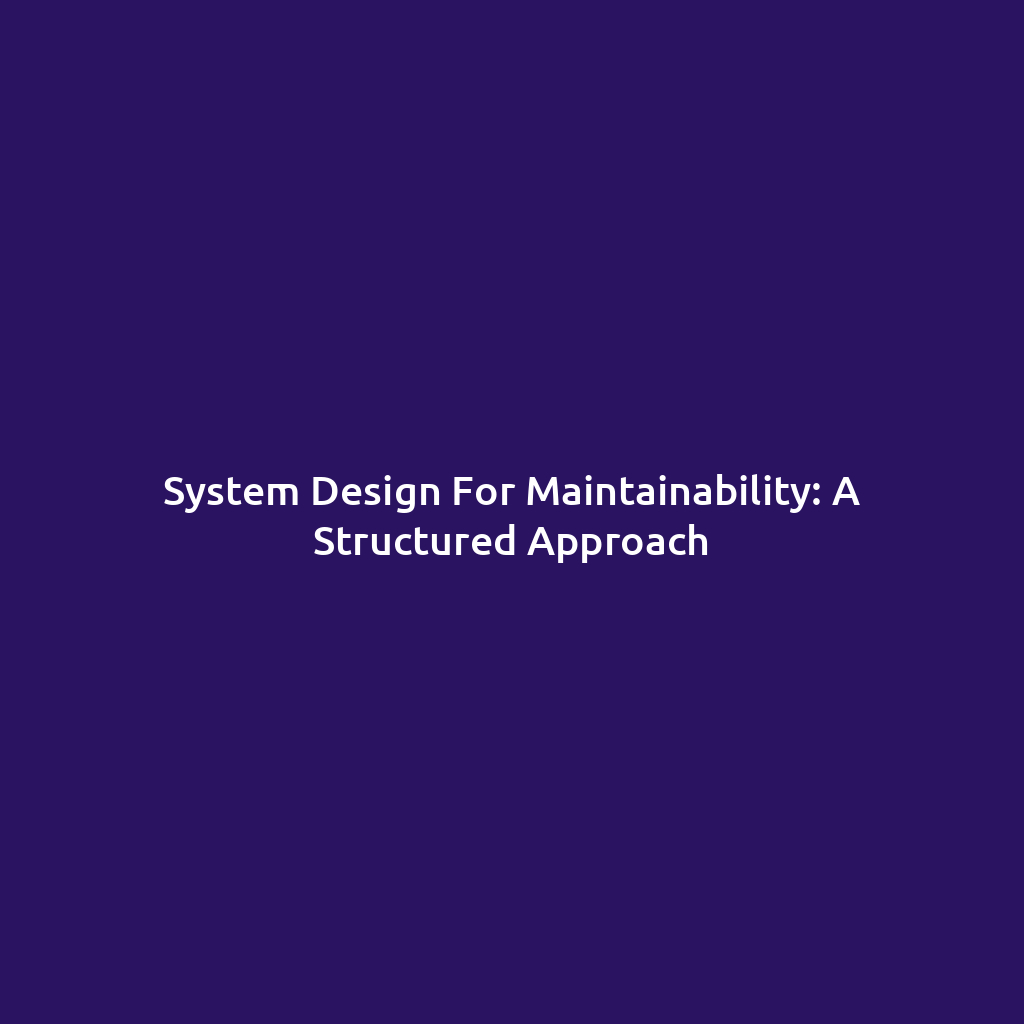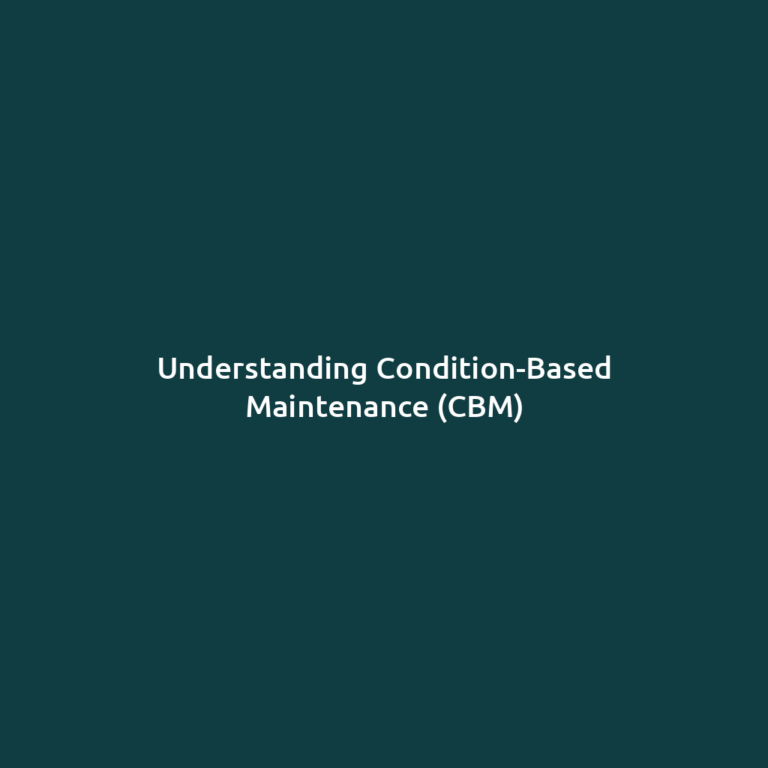System Design for Maintainability: A Structured Approach
When embarking on any engineering or technological endeavor, integrating system design for maintainability from the onset is essential for long-term efficiency and reduced operational headaches. It’s not just about building a system that works; it’s about building one that endures, evolves and performs seamlessly under pressure.
Whether you’re dealing with complex IT infrastructure or mechanical systems, the goal is to create a robust framework that simplifies maintenance, minimizes downtime and lowers costs.
Let’s break down how to approach this structured design methodically, blending engineering insights with real-world applications.
Table of Contents
- 1 Why System Design for Maintainability Matters
- 2 Core Principles of System Design for Maintainability
- 3 Steps to Implement System Design for Maintainability
- 4 Industries Benefiting from System Design for Maintainability
- 5 Success in Maintainable System Design
- 6 Tools and Technologies Enhancing System Design for Maintainability
- 7 Frequently Asked Questions About System Design for Maintainability
Why System Design for Maintainability Matters
Maintenance is inevitable. Systems age, components degrade and software becomes outdated. A well-thought-out system design for maintainability not only ensures longevity but also streamlines the troubleshooting and repair process. Imagine an automotive assembly line where a single malfunctioning robot halts production.
Now imagine if diagnosing and fixing that robot required dismantling half the assembly line – inefficient, right?
This is where maintainable systems shine. They are structured with accessibility, modularity and diagnostics in mind. This approach minimizes disruptions making it easier to address issues without overhauling the entire system.
Key reasons why maintainability matters:
-
Reduced Downtime: Easily accessible components lead to quicker repairs.
-
Cost Efficiency: Fewer resources are spent on labor-intensive maintenance.
-
Improved Reliability: Systems designed with maintainability are less prone to cascading failures.
-
Sustainability: Enhanced maintainability reduces the need for frequent replacements, aligning with sustainable practices.
Core Principles of System Design for Maintainability
Developing a system with maintainability at its core requires a strategic approach. These principles guide the process:
1. Accessibility
Accessible systems are easier to maintain. Every part, whether physical or digital, should be reachable without unnecessary disassembly or decoding.
-
Practical Example: Modular server racks with slide-out components make replacing a faulty unit simple, minimizing service disruption.
-
Implementation Tip: Design components with clearly labeled access points and prioritize ergonomics in physical systems.
2. Modularity
Breaking systems into interchangeable modules reduces complexity during maintenance.
-
Real-World Use Case: In software, microservices architecture is a stellar example. Each service operates independently, so fixing one doesn’t disrupt the others.
-
Implementation Tip: Ensure modules have standardized interfaces to facilitate seamless replacements.
3. Diagnostic Tools
Incorporating diagnostics into the design ensures issues are identified before they escalate.
-
Example: Automotive onboard diagnostics (OBD) systems alert users to potential problems with precise error codes.
-
Implementation Tip: Include self-diagnostic capabilities in systems, such as sensors and logs for early detection.
4. Standardization
Using standardized parts or processes ensures easy sourcing and replacement.
-
Practical Scenario: A manufacturing plant that uses standardized bearings across all machinery simplifies inventory and repair processes.
-
Implementation Tip: Opt for widely available components to prevent sourcing delays.
5. Documentation
Clear, concise documentation is invaluable for maintenance teams.
-
Illustration: A well-documented API allows developers to troubleshoot integrations efficiently.
-
Implementation Tip: Pair written instructions with visual aids like diagrams or flowcharts.
Steps to Implement System Design for Maintainability
Adopting a structured approach ensures no critical aspect of maintainability is overlooked. Follow these steps to create systems optimized for maintenance:
Step 1: Define Maintenance Objectives
Start by understanding the system’s lifecycle and anticipated maintenance needs. Consider:
-
Frequency of maintenance
-
Skill levels required
-
Potential challenges in the operating environment
Step 2: Analyze System Requirements
Identify critical components and predict failure points. Use historical data or simulations to inform your design decisions.
Step 3: Incorporate Maintainability in Design
At this stage, prioritize features like modularity, accessibility and diagnostics. Collaborate with maintenance teams to understand their needs.
Step 4: Test for Maintainability
Prototype testing is vital. Simulate maintenance scenarios to evaluate how easily the system can be repaired or upgraded.
-
Case in Point: Testing modular drones by swapping out damaged propellers and observing time and resource efficiency.
Step 5: Monitor and Refine Post-Deployment
Maintenance doesn’t end at implementation. Use performance data to identify areas for improvement, ensuring the system evolves alongside changing demands.
Industries Benefiting from System Design for Maintainability
The concept of maintainability transcends industries, providing unparalleled advantages across diverse sectors.
Manufacturing
With heavy reliance on machinery, manufacturers benefit immensely from modular and accessible designs. Predictive maintenance, enabled by embedded diagnostics, reduces unplanned downtime.
Aerospace
In aerospace, reliability is non-negotiable. Aircraft systems are meticulously designed for maintainability, ensuring that routine inspections or part replacements don’t compromise safety or schedules.
IT and Software
Scalability and upgradability are vital in IT. Cloud-based solutions, designed with modularity and robust documentation, ensure systems remain future-proof.
Healthcare
Medical devices and hospital systems must be operational round-the-clock. Accessible design and standardized parts enable swift repairs and reduce patient care disruptions.
Success in Maintainable System Design
Let’s explore how maintainability revolutionized a real-world scenario.
-
The Challenge: A data center faced frequent server failures, resulting in prolonged downtime.
-
The Solution: Engineers redesigned the server racks for modularity, allowing hot-swapping of components without shutting down the system.
-
The Outcome: Maintenance time dropped by 70% and operational efficiency improved significantly.
Tools and Technologies Enhancing System Design for Maintainability
Technology plays a pivotal role in maintainability. Consider these innovations:
-
IoT Sensors: Provide real-time data for predictive maintenance.
-
3D Printing: Enables quick fabrication of replacement parts.
-
AR Maintenance Guides: Augmented reality simplifies troubleshooting with interactive overlays.
System design for maintainability isn’t just a best practice; it’s a necessity in today’s fast-paced, resource-conscious world. By focusing on accessibility, modularity and diagnostics organizations can create systems that are not only efficient but also future-ready. Whether in manufacturing, IT or healthcare, the principles of maintainable design provide a roadmap to operational success.
Every system is an opportunity to innovate and with maintainability as a guiding principle, the possibilities are endless. By embedding these strategies into your design process, you ensure a legacy of efficiency, adaptability and resilience.
Frequently Asked Questions About System Design for Maintainability
1. What is system design for maintainability?
System design for maintainability is an engineering approach that focuses on creating systems that are easy to maintain, repair and upgrade. It involves incorporating features like modularity, accessibility, diagnostics and standardization to simplify troubleshooting and ensure long-term efficiency.
2. Why is maintainability important in system design?
Maintainability is crucial because it minimizes downtime, reduces maintenance costs and improves system reliability. Systems designed for maintainability are easier to troubleshoot and repair, ensuring seamless operation with fewer disruptions.
3. How does modularity improve maintainability?
Modularity breaks down a system into smaller, independent components. This makes it easier to replace or repair faulty parts without affecting the entire system, saving time and resources during maintenance.
4. What role does documentation play in system maintainability?
Comprehensive documentation provides maintenance teams with clear instructions on troubleshooting, repairs and upgrades. It ensures consistency, reduces errors and speeds up the maintenance process, especially for complex systems.
5. How can diagnostics be integrated into system design?
Diagnostics can be incorporated through sensors, logs and self-monitoring tools. These elements provide real-time data on system performance, allowing for early detection of issues before they escalate into major problems.
6. What industries benefit most from maintainable system design?
Industries like manufacturing, aerospace, IT, healthcare and construction benefit significantly from maintainable system design. These sectors rely on systems that are operationally critical and require minimal downtime.
7. Can existing systems be redesigned for better maintainability?
Yes, existing systems can be retrofitted for maintainability by adding modular components, improving accessibility, updating documentation and integrating diagnostic tools. However, this process can be more complex and costly compared to designing for maintainability from the start.
8. What are the common challenges in achieving maintainable system design?
Challenges include balancing complexity with simplicity, ensuring compatibility across components, addressing the skill levels of maintenance teams and staying within budget constraints while implementing maintainability features.
9. How does maintainability align with sustainability?
Maintainable systems reduce waste by minimizing the need for replacements and repairs. They also consume fewer resources during their lifecycle, aligning with sustainability goals and promoting environmentally conscious practices.
10. What future technologies will enhance system maintainability?
Emerging technologies like AI-driven predictive maintenance, IoT-enabled diagnostics, augmented reality maintenance guides and advanced material engineering are set to revolutionize system maintainability, making systems smarter, more efficient and easier to manage.





